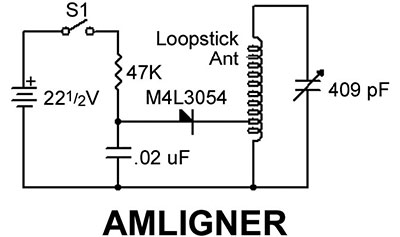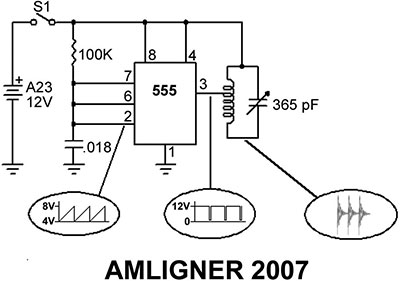With TJ Byers
AM Frequency Generator
Question:
In the 1968 winter edition of the Popular Electronics Experimenter’s Handbook, Don Lancaster published a simple signal generator project called the AMLIGNER, that used nothing more than a diode, a resistor, a coil, and two capacitors (see Figure).

The diode was a Motorola M4L3054 four-layer device that is no longer available. Is there any substitute for the M4L3054? If not, what is your recommendation?
— Dennis L. Farkas
Ocala, FL
Answer:
While there is a four-layer diode equivalent of the M4L3054, I doubt it will fit comfortably into the original design. Aptly named a diac, this family of breakover diodes are made to trigger triacs in phase-controller circuits. Unfortunately, they have a characteristic breakover voltage range of 27 to 70 volts — far in excess of the 12 volt design voltage.
What is my recommendation?
To use a 555 timer configured as a relaxation oscillator — a.k.a., a sawtooth oscillator. Like a breakover diode, the 555 lets a timing capacitor charge to a predetermined voltage, at which time it discharges the capacitor and generates an output pulse. And like the breakover diode, it needs only two external parts — a timing resistor and a timing capacitor — to ccomplish this. The 555 has the added benefit that the input trigger is isolated from the output pulse, which means the impossible-to-find 22 1/2 volt battery can be replaced with a much smaller A23 (wireless doorbell) 12 volt alkaline battery. The new AMLIGNER is shown in below.

Because the original design is 40 years old and built with parts of its day, a few words about construction are in order. The tuning coil is a loopstick antenna salvaged from an AM transistor radio. They are easy to identify; just look for a coil wrapped around a three-inch (or so) ferrite rod. The coil may be tapped, or there could be a smaller second coil wound over the first. While you’re at it, snag the tuning capacitor, too. However, it’s been a long time since I’ve seen a six-transistor AM radio, so I suggest buying a loopstick antenna (see websites below). Again, pair the tuning cap to the antenna because its value will change as the inductance of the different loopsticks changes. For example, the loopstick antenna sold by Scitoys requires a 160 pF tuning cap which — not coincidentally — happens to be the only variable cap they sell. Other than that, feel free to express yourself with your rendition of the new AMLIGNER 2007.
www.angelfire.com/electronic2/index1/index.html
www.scitoyscatalog.com
www.hobbytron.com



Comments